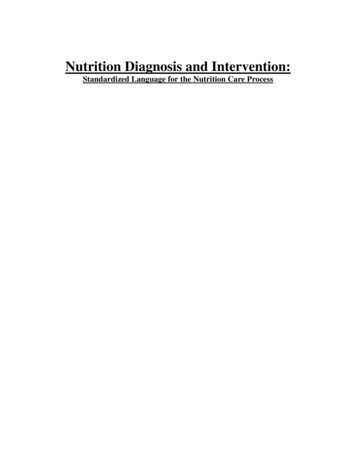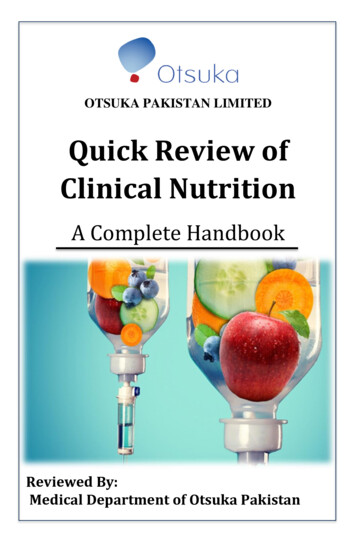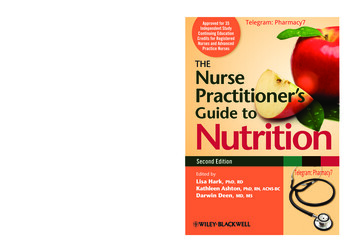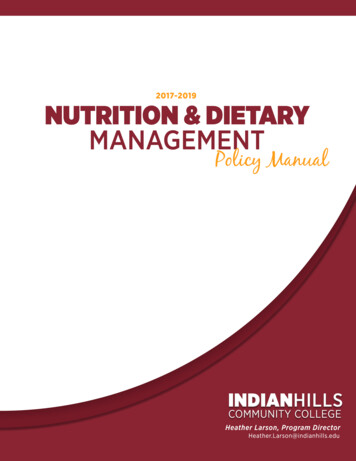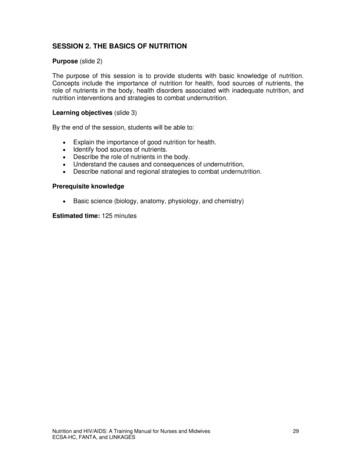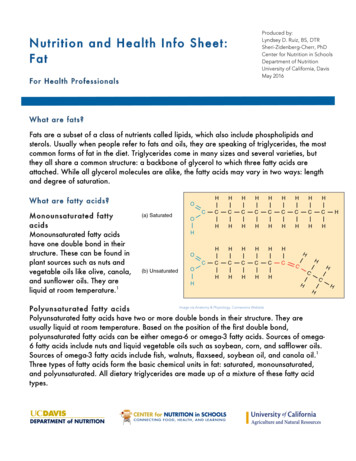
Transcription
Nutrition and Health Info Sheet:FatFor Health ProfessionalsProduced by:Lyndsey D. Ruiz, BS, DTRSheri-Zidenberg-Cherr, PhDCenter for Nutrition in SchoolsDepartment of NutritionUniversity of California, DavisMay 2016What are fats?Fats are a subset of a class of nutrients called lipids, which also include phospholipids andsterols. Usually when people refer to fats and oils, they are speaking of triglycerides, the mostcommon forms of fat in the diet. Triglycerides come in many sizes and several varieties, butthey all share a common structure: a backbone of glycerol to which three fatty acids areattached. While all glycerol molecules are alike, the fatty acids may vary in two ways: lengthand degree of saturation.What are fatty acids?Monounsaturated fattyacidsMonounsaturated fatty acidshave one double bond in theirstructure. These can be found inplant sources such as nuts andvegetable oils like olive, canola,and sunflower oils. They areliquid at room temperature.1Image via Anatomy & Physiology, Connexions WebsitePolyunsaturated fatty acidsPolyunsaturated fatty acids have two or more double bonds in their structure. They areusually liquid at room temperature. Based on the position of the first double bond,polyunsaturated fatty acids can be either omega-6 or omega-3 fatty acids. Sources of omega6 fatty acids include nuts and liquid vegetable oils such as soybean, corn, and safflower oils.Sources of omega-3 fatty acids include fish, walnuts, flaxseed, soybean oil, and canola oil.1Three types of fatty acids form the basic chemical units in fat: saturated, monounsaturated,and polyunsaturated. All dietary triglycerides are made up of a mixture of these fatty acidtypes.
Saturated fatty acidsSaturated fatty acids do not have double bonds in there structure. These are concentrated infats from meat and dairy products. Saturated fatty acids are also found in medium-chain fattyacids, such as tropical oils like coconut, palm, and palm kernel oils. Fats that are high insaturated fatty acids are generally solid at room temperature.1What are trans fatty acids?Trans fatty acids are the product of hydrogenating oils, a process that converts liquid fat tosolid fat. This method has been used by many food manufacturers because it extends the shelflife of foods, increases resistance to rancidity, and is fairly inexpensive. Trans fatty acids alsooccur naturally in some animal products. 1Studies have found that trans fats raise low density lipoprotein cholesterol (LDL-C) and totalcholesterol and suggest a correlation between cardiovascular disease and trans fat intake.1Due to concern about this correlation, the Food and Drug Administration (FDA) requiresinformation about the trans fat content of foods on nutrition food labels. Since the effectivedate of this requirement, January 1, 2006, average consumption of industrially-producedtrans fat has significantly decreased from 3 to about 0.6 percent of total calorie intake in theUnited States.3What functions do fats serve?Triglycerides are mainly responsible for storing energy and insulating the body and organs.They also transport vitamins that are fat-soluble and contribute to taste and feeling full aftereating a meal.4Fat can be found in various forms in the diet and each form can serve a different purpose.Essential fatty acids are omega-3 and omega-6 fatty acids that the human body is not able tocreate in adequate amounts, and must come from food sources.1 Alpha-linolenic acid (omega3) and linoleic acid (omega-6) are the two essential fatty acids; they play a key role in theimmune system, vision, and cell structure. Good foodsources for these essential fatty acids include vegetableoils that can be found in mayonnaise and saladdressings. Other omega-3 fatty acids areeicosapentaenoic acid (EPA) and docosahexaenoicacid (DHA) which are important for the immune system,cellular processes, and neural responses.1,4 These fattyacids are abundant in fish such as salmon, halibut, andtrout.Photo by: cattalin via pixabay
How much fat should be included in your diet?The 2015-2020 Dietary Guidelines for Americans recommends limiting total fat to 20 to 35percent of total daily calories and saturated fat to no more than 10 percent of total dailycalories.1,2 According to the most recent report from the Institute of Medicine’s Food andNutrition Board on Acceptable Macronutrient Distribution Range for Fat, the suggested goalis to maintain a total dietary fat intake of 20 to 35 percent for adults, 30 to 40 percent forchildren ages 1 to 3, and 25 to 35 percent for children ages 4 to 18.5When does too much fat become a problem?A substantial rise in the prevalence of obesity among children and adults in the United Stateshas been observed.6 National statistics show that approximately 30 percent of children andadolescents and over 68 percent of adults are considered overweight or obese.6 This trendcontributes to the population being at greater risk of developing chronic conditions such astype II diabetes and cardiovascular disease.1 Factors contributing to obesity are large portionsizes, low intakes of nutrient-dense foods, and inadequate exercise.1 Furthermore somenutrients, such as saturated fat, are a concern for overconsumption.1What is the relation between fat and cardiovascular disease?Cardiovascular disease (CVD) is a public health concern because an estimated 83.6 million,or 1 in 3, Americans have at least one type of CVD.7 Risk factors for CVD include inactivity,high serum triglycerides and cholesterol, and overweight and obesity.8 While some fat isessential in our diet, it is recommended to monitor fat consumption.1 Onaverage, about 36 percent of daily calories comes from total fat andalmost 12 percent from saturated fat in American diets.1,9 Althoughsaturated fat consumption has shown no significant association withincidence of CVD, replacing saturated fat with unsaturated fat,particularly polyunsaturated fat, has been associated with reduced riskby lowering triglycerides, total cholesterol, and LDL-C in the blood.7,8 Alow cholesterol diet was previously believed to lower serum cholesterol,however studies have found no relationship between consumption ofdietary cholesterol and levels of serum cholesterol.1,8Photo by: Keith Weller, AgriculturalResearch Service, USDADietary patterns that have shown positive results in reducing risk of CVDare rich in vegetables, fruit, whole grains, low- and non-fat dairy, and seafood, low inred/processed meats, and include regular intake of nuts and legumes.8 Avoiding partiallyhydrogenated oils containing trans fat is also recommended.1 This diet can be achieved andtailored to individual needs through multiple dietary patterns.1
What is the relation between fat and cancer?There is some evidence that diets higher in vegetables, fruit, whole grains, lean meats, andseafood, and lower in red/processed meats and saturated fatty acids are associated with alower risk of certain cancers, especially colorectal and breast.1 However, the NationalCancer Institute does not support any diet for prevention of breast, colorectal, lung, orprostate cancers.10-13 Studies are currently being conducted to determine if different dietmodifications can help prevent certain cancers. 10-13 There is some emerging research ofmedium chain fatty acids inhibiting growth of certain human cancer cells.14 However, studieshave only been conducted in vitro so conclusions on potential effective in vivo cannot bedrawn until further research is conducted.14 Thus, the best advice is maintaining a healthybody weight and getting regular physical activity.1The preparation of food is also of importance. Deep-frying foods or charbroiling them untilthey have a burned surface may pose a risk to the consumer since this process results indevelopment of potential carcinogens through fat oxidization.15What is the relation between fat and mental health?Studies for dietary patterns to aid in mental health disorders are very recent and stilldeveloping evidence.1 Omega-3 fatty acids DHA and EPA are the most studied in relation toneural health.1 Some studies have found DHA to aid in neural signaling speed and EPA tohave antidepressive properties when used in combination with other treatments.1,16 Due toenough strong evidence of favorable results, the American Psychological Association usessupplementation with DHA and EPA for major depressive disorders.16How is fat intake calculated?You can determine the number of grams of fat that provide 30 percent of calories in the dailydiet as follows: Multiply the total calories for one day by 0.30 to get the recommended amount of caloriesfrom fat per day. (Example: 1,800 calories x 0.30 540 calories from fat. So if youconsume 1,800 calories per day, about 540 calories should come from fat.) Divide calories from fat per day by 9 (each gram of fat contains 9 calories) to get gramsof fat recommended per day. (Example: 540 calories from fat divided by 9 60 grams offat.)What are some ways to control fat intake?The 2015-2020 Dietary Guidelines for Americans recommends taking a food-based, total dietapproach to meet recommendations.1,2 There are several strategies to help reduce fatconsumption including smaller portions and recipe modifications.1Here are a few simple dietary suggestions to accomplish this goal:
Consume 7 to 9 servings of fruits and vegetables each day to partially replace fatty foodsand promote satiety. Add a mixture of whole grain products to the diet. Replace fatty meats with skinless chicken, fish, or other lean meats, and drink fat-free orlow-fat milk instead of whole milk. Include a wide variety of food and beverages.Diets very low in fat are generally not recommended because fat is often replaced withrefined carbohydrates which has generally been associated with dyslipidemia throughhypertriglyceridemia and low high density lipoprotein cholesterol (HDL-C) concentrations.1,8Dietary fat consumption should be balanced instead of reducing total fat.1 What are some food sources for different kinds of fats? Saturated fatty acidsMeat, poultry, and whole-dairy productsMedium-chain fatty acidsCoconut and palm oilsMonounsaturated fatty acidsOlive and canola oil, peanuts, and avocadosPolyunsaturated fatsSafflower, sunflower, corn, and soybean oils, as well as fishOmega-3 fatty acidsFish such as salmon and trout, shellfish, walnuts, flaxseed,and canola oilPhoto by: margenauer via pixabayOmega-6 fatty acidsSalad dressings, soybean oil, corn oil, and nutsTrans fatty acidsPackaged baked goods, chips, stick margarine, and some animal productsWhat is the total fat, saturated fat, and unsaturated fat content of somecommon foods? 17Total fat (g)Saturated fat(g)Monounsaturatedfat (g)Polyunsaturatedfat (g)Meat, Poultry, Fish, and EggsGround beef, cooked, pan-broiled, 3 ozpatty80 percent lean & 20 percent fat95 percent lean & 5 percent fatPork, chop, cooked, broiled, 3 ozChicken, light & dark meat, roasted, 3 ozWith skinWithout 21.74.52.32.51.4
Total fat (g)Saturated fat(g)Monounsaturatedfat (g)Polyunsaturatedfat (g)Tuna, canned, 3 ozIn oilIn water6.92.51.10.72.80.72.50.9Shrimp, cooked, 3 oz0.20.00.00.1Eggs, large, cooked, 1Whole, hard-boiledWhites only5.30.01.60.02.00.00.70.0Dairy ProductsMilk, 1 cup2 percent fat1 percent fatSkim , 8 oz containerNonfat, planLow-fat, plainLow-fat, fruit flavored0.43.52.50.32.31.60.11.00.70.00.10.1Greek yogurt, 6 oz containerNonfat, planLow-fat, plainLow-fat, fruit 33.00.4Margarine, regular, 1 tsp3.80.81.81.0Olive oil, 1 tsp4.50.63.30.5Mayonnaise, regular, 1 tbsp10.31.62.36.2Coconut oil, 1 tbsp13.511.20.90.25.02.91.30.218.07.96.91.3Fats, Oils, SweetsButter, salted, 1 tbspCream cheese, 1 tbspCheesecake, commercially prepared,1/6 of 17 oz cakeBeans, Nuts, SeedsPinto beans, canned, 1 cup1.50.30.30.5Black beans, canned, 1 cup0.50.10.00.2Peanuts, oil roasted with salt, 1 oz14.92.57.44.3Walnuts, dry roasted with salt, 1 r seeds, dry roasted with salt, 1ozSesame seeds, whole, roasted andtoasted, 1 oz
Acknowledgements:Nadine J. Kirkpatrick, PhD, Cristy Hathaway, BS, and Karrie Heneman, PhD contributed tothis Fact Sheet.References:1. US Department of Agriculture and US Department of Health and Human Services. 2015. Scientific Report ofthe 2015 Dietary Guidelines Advisory Committee. Dietary Guidelines for American 5-DietaryGuidelines-Advisory-Committee.pdf.2. US Department of Health and Human Services and US Department of Agriculture. 2015-2020 DietaryGuidelines for Americans. 8th Edition. December 2015. Available nes/.3. Doell D, Folmer D, Lee H, Honigfort M, Carberry S. Updated estimate of trans fat intake by the USpopulation. Food Addit Contam Part A Chem Anal Control Expo Risk Asses. 2012; 29 (6): 861-874.4. Nelms, MN, Sucher, KP, Lacey, K. Nutrition Therapy and Pathophysiology. 3rd ed. Boston, MA: CengageLearning; 2014.5. Institute of Medicine, Dietary Reference Intakes for Energy, Carbohydrate, Fiber, Fat, Fatty Acids,Cholesterol, Protein, and Amino Acids (Macronutrients); 2002; National Academy Press; www.nap.edu.6. Ogden CL, Carroll MD, Kit BK, Flegal KM. Prevalence of childhood and adult obesity in the united states,2011-2012. JAMA. 2014; 311(8): 806-814.7. Go AS, Mozaffarian D, Roger VL, Benjamin EJ, Berry JD, Blaha MJ, et al. Heart disease and stroke statistics-2014 update: a report from the American Heart Association. Circulation. ubmed/24352519.8. Eckel RH, Jakicic JM, Ard JD, de Jesus JM, Houston Miller N, Hubbard VS, et al. 2013 AHA/ACC guidelineon lifestyle management to reduce cardiovascular risk: a report of the American College ofCardiology/American Heart Association Task Force on Practice Guidelines. Circulation. 2014;129(25 Suppl2):S76-99.9. U.S. Department of Agriculture, Agricultural Research Service. 2014. Nutrient Intakes from Food andBeverages: Mean Amounts Consumed per Individual, by Gender and Age, What We Eat in America,NHANES 2011-2012.10. National Cancer Institute: PDQ Breast Cancer ent/breast-prevention-pdq. Updated October 22, 2015. AccessedDecember 30, 2015.11. National Cancer Institute: PDQ Colorectal Cancer patient/colorectal-prevention-pdq. Updated July 23, 2015.Accessed December 30, 2015.12. National Cancer Institute: PDQ Lung Cancer Prevention. ntion-pdq. Updated November 4, 2015. Accessed December 30, 2015.13. National Cancer Institute: PDQ Prostate Cancer tient/prostate-prevention-pdq. Updated July 31, 2015. AccessedDecember 30, 2015.14. Narayanan A, Baskaran SA, Amalaradjou MAR, Venkitanarayanan K. Anticarcinogenic properties ofmedium chain fatty acids on human colorectal, skin and breast cancer cells in vitro. Int J Mol Sci. 2015;16(3): 5014-5027.15. Capuano E, Fogliano V. Acrylamide and 5-hydroxymethylfurfural (HMF): A review on metabolism, toxicity,occurrence in food and mitigation strategies. LWT-Food Science and Technology. 2015; 44(4): 793-810.16. Gelenberg AJ, Freeman MP, Markowitz JC, Rosenbaum JF, Thase ME, Trivedi MH, et al. Practice Guidelinefor the Treatment of Patients With Major Depressive Disorder, Third Edition. ewide/practice guidelines/guidelines/mdd.pdf.17. National Nutrient Database for Standard Reference Release 28. United States Department of AgricultureAgricultural Research Service Website. http://ndb.nal.usda.gov/ndb/search. Accessed December 28,2015.
The University of California prohibits discrimination or harassment of any person on the basis of race, color, nationalorigin, religion, sex, gender identity, pregnancy (including childbirth, and medical conditions related to pregnancyor childbirth), physical or mental disability, medical condition (cancer-related or genetic characteristics), ancestry,marital status, age, sexual orientation, citizenship, or service in the uniformed services (as defined by the UniformedServices Employment and Reemployment Rights Act of 1994: service in the uniformed services includesmembership, application for membership, performance of service, application for service, or obligation for servicein the uniformed services) in any of its programs or activities.University policy also prohibits reprisal or retaliation against any person in any of its programs or activities formaking a complaint of discrimination or sexual harassment or for using or participating in the investigation orresolution process of any such complaint.University policy is intended to be consistent with the provisions of applicable State and Federal laws.Inquiries regarding the University’s nondiscrimination policies may be directed to the Affirmative Action/EqualOpportunity Director, University of California, Agriculture and Natural Resources, 1111 Franklin Street, 6th Floor,Oakland, CA 94607, (510) 987-0096.Copyright The Regents of the University of California, Davis campus, 2016. All rights reserved. Inquiriesregarding this publication may be directed to cns@ucdavis.edu. The information provided in this publication isintended for general consumer understanding, and is not intended to be used for medical diagnosis or treatment,or to substitute for professional medical advice.
3) and linoleic acid (omega-6) are the two essential fatty acids; they play a key role in the immune system, vision, and cell structure. Good food sources for these essential fatty acids include vegetable oils that can be found in mayonnaise and salad dressings. Other omega-3 fatty acids are eicosapentaenoic acid (EPA) and docosahexaenoic

